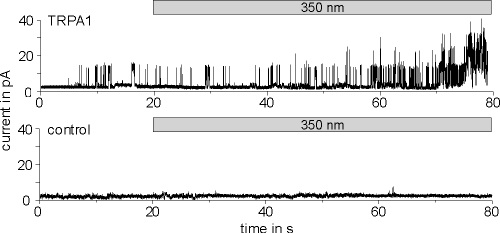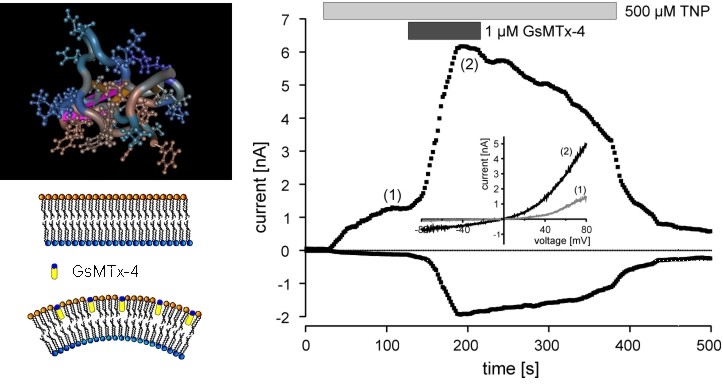Activation mechanisms of TRPA1
Ultraviolet light and photosensitising agents activate TRPA1 via generation of oxidative stress
TRPA1 is a poorly selective Ca2+ channel which is expressed in a subpopulation of sensory neurones and mediates a variety of sensory processes like the detection of painful stimuli. The activation mechanisms are diverse and, yet, not fully understood. We could recently show that light-induced activation of TRPA1 provides an additional mode of activation, possibly via generation of oxidative stress.Moreover, photosensitising agents such as acridine orange, hypericin, and 5-ALA, which are widely used for photodynamic therapy, shift the UVA-induced activation of TRPA1 to light in the visible range, linking TRPA1 to the painful sensations which are frequently observed during photodynamic therapy.

TRPA1 activation by membrane bending?
Little is known about mechanical transduction in sensory neurones. Studies from knock out mouse show that TRPA contributes to cold and chemical nociception but there are conflicting reports about its role in mechanical transduction. Additional evidence for a role of TRPA1 in mediating mechanosensation comes from the C. elegans ortholog, which is activated in response to mechanical stimuli both in vitro and in vivo. We have previously shown that Gsmtx-4, a toxin of the Chilean rose tarantula Grammostola spatulata, which is a known modulator of mechanosensitive channels, potently activates TRPA1. Moreover, amphipathic molecules such as trinitrophenol and chlorpromazine, which selectively insert into the outer and inner leaflet of the plasma membrane, cause an activation of TRPA1 or modulate its voltage-dependent gating, rendering membrane bending as another possible mechanism for TRPA1 activation.
